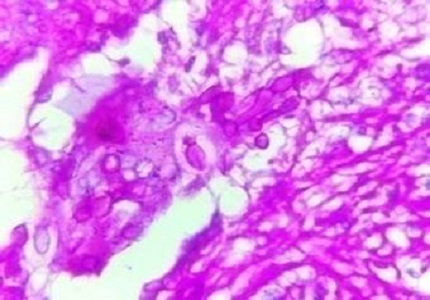The Madura Foot: A case of eumycotic mycetoma on histopathology
Keywords:
Madura foot, Eumycetoma, Actinomycetoma
Abstract
Madura foot is a deep mycosis commonly seen in tropical and subtropical countries such as India. It is caused by two groups of organisms, bacteria belonging to the group of Actinomycetes and the true mycetes named eumycetes. The incidence is more common in agricultural workers. Generally these lesions were present on foot & shows presence of induration, fibrosis and minimal discharge from sinuses. Though culture remains the gold standard diagnostic test histopathology plays important role in the early diagnosis and definitive treatment of these cases.
Downloads
Download data is not yet available.
References
1. Azzoni R, Capitza P; Madura’s foot in native of the Philippines immigrant in northern Italy.J Orthop., 2005; 2(6): 1-6.
2. Alam K, Maheshwari V, Bhargava S, Jain A, Fatima U, Haq EU. Histological diagnosis of madura foot (mycetoma): a must for definitive treatment. J Glob Infect Dis. 2009 Jan;1(1):64-7. doi: 10.4103/0974-777X.52985. [PubMed]
3. Davis JD, Stone PA, McGarry JJ. Recurrent mycetoma of the foot. J Foot Ankle Surg. 1999 Jan-Feb;38(1):55-60. [PubMed]
4. Fahal AH. Mycetoma: a thorn in the flesh. Trans R Soc Trop Med Hyg. 2004 Jan;98(1):3-11. [PubMed]
5. Magana M. Mycetoma. Int J Dermatol. 1984 May;23(4):221-36.
6. Iffat H, Abid K. Mycetoma Revisited. NDermatol Online, 2011; 2(3): 147-150.
7. Mohammad N, Arif C, Ruksana P, Rokon U,Abdur R, Moydul H; The Madura foot. A CaseReport. N Dermatol Online, 2011; 2(2): 70-73.
8. Negroni R, Lopez Daneri G, Arechavala A,Bianchi MH, Robles AM; Clinical and microbiological study of mycetomas at theMuniz Hospital of Buenos Aires between 1989 and 2004. Rev Argent Microbiol., 2006; 38(1):13-18. [PubMed]
9. Pilsczek FH, Augenbraun M. Mycetoma fungal infection: multiple organisms as colonizers or pathogens? Rev Soc Bras Med Trop. 2007 Jul-Aug;40(4):463-5. [PubMed]
10. van de Sande WW, de Kat J, Coppens J, Ahmed AO, Fahal A, Verbrugh H, van Belkum A. Melanin biosynthesis in Madurella mycetomatis and its effect on susceptibility to itraconazole and ketoconazole. Microbes Infect. 2007 Jul;9(9):1114-23. Epub 2007 May 18.
11. Chufal SS, Thapliyal NC, Gupta MK. An approach to histology-based diagnosis and treatment of Madura foot. J Infect Dev Ctries. 2012 Sep 17;6(9):684-8. doi: 10.3855/jidc.2387. [PubMed]
12. Taralakshmi VV, Pankajalakshmi VV, Arumugam S, Subramanian S. Mycetoma caused by Madurella mycetomii in Madras. Australas J Dermatol. 1978 Dec;19(3):125-9. [PubMed]
13. Fahal AH, Mycetoma: Clinico-pathological Monograph, University of Khartoum Press.2006, pp 23-30.
14. Ahmed Hassan Fahal; Mycetoma. Khartoum Medical Journal, 2011; 4(1): 514 – 523.
2. Alam K, Maheshwari V, Bhargava S, Jain A, Fatima U, Haq EU. Histological diagnosis of madura foot (mycetoma): a must for definitive treatment. J Glob Infect Dis. 2009 Jan;1(1):64-7. doi: 10.4103/0974-777X.52985. [PubMed]
3. Davis JD, Stone PA, McGarry JJ. Recurrent mycetoma of the foot. J Foot Ankle Surg. 1999 Jan-Feb;38(1):55-60. [PubMed]
4. Fahal AH. Mycetoma: a thorn in the flesh. Trans R Soc Trop Med Hyg. 2004 Jan;98(1):3-11. [PubMed]
5. Magana M. Mycetoma. Int J Dermatol. 1984 May;23(4):221-36.
6. Iffat H, Abid K. Mycetoma Revisited. NDermatol Online, 2011; 2(3): 147-150.
7. Mohammad N, Arif C, Ruksana P, Rokon U,Abdur R, Moydul H; The Madura foot. A CaseReport. N Dermatol Online, 2011; 2(2): 70-73.
8. Negroni R, Lopez Daneri G, Arechavala A,Bianchi MH, Robles AM; Clinical and microbiological study of mycetomas at theMuniz Hospital of Buenos Aires between 1989 and 2004. Rev Argent Microbiol., 2006; 38(1):13-18. [PubMed]
9. Pilsczek FH, Augenbraun M. Mycetoma fungal infection: multiple organisms as colonizers or pathogens? Rev Soc Bras Med Trop. 2007 Jul-Aug;40(4):463-5. [PubMed]
10. van de Sande WW, de Kat J, Coppens J, Ahmed AO, Fahal A, Verbrugh H, van Belkum A. Melanin biosynthesis in Madurella mycetomatis and its effect on susceptibility to itraconazole and ketoconazole. Microbes Infect. 2007 Jul;9(9):1114-23. Epub 2007 May 18.
11. Chufal SS, Thapliyal NC, Gupta MK. An approach to histology-based diagnosis and treatment of Madura foot. J Infect Dev Ctries. 2012 Sep 17;6(9):684-8. doi: 10.3855/jidc.2387. [PubMed]
12. Taralakshmi VV, Pankajalakshmi VV, Arumugam S, Subramanian S. Mycetoma caused by Madurella mycetomii in Madras. Australas J Dermatol. 1978 Dec;19(3):125-9. [PubMed]
13. Fahal AH, Mycetoma: Clinico-pathological Monograph, University of Khartoum Press.2006, pp 23-30.
14. Ahmed Hassan Fahal; Mycetoma. Khartoum Medical Journal, 2011; 4(1): 514 – 523.

CITATION
DOI: 10.17511/jopm.2017.i03.14
Published: 2017-09-30
How to Cite
Dr. D.S. Jadhav, Dr. Anuja U. Paul, Dr. B. D. Baste, & Dr. A. G. Valand. (2017). The Madura Foot: A case of eumycotic mycetoma on histopathology. Tropical Journal of Pathology and Microbiology, 3(3), 309-312. https://doi.org/10.17511/jopm.2017.i03.14
Section
Case Report


 OAI - Open Archives Initiative
OAI - Open Archives Initiative


